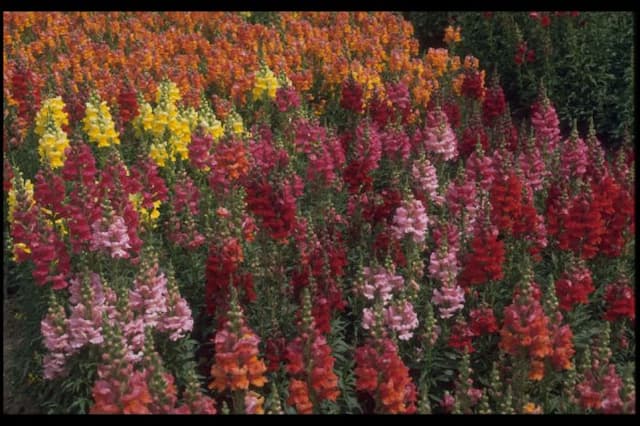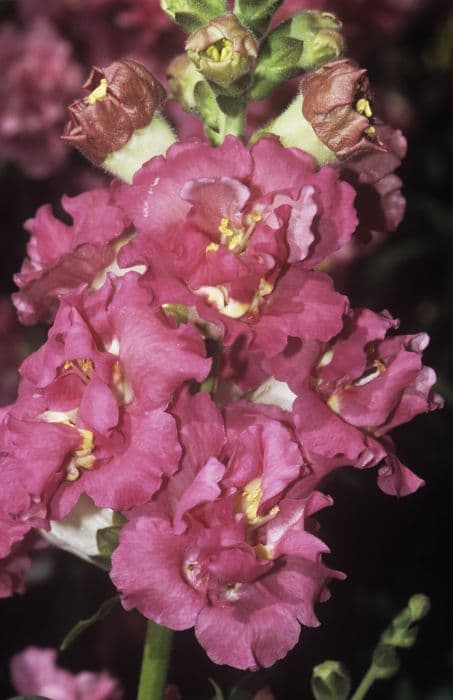Beardtongue Penstemon 'George Home'

ABOUT
The Penstemon 'George Home' is a visually striking plant that is well-loved for its ornamental qualities. It boasts a profusion of tubular flowers that are a magnet for pollinators like bees and hummingbirds. The flowers come in a vibrant shade that could range from deep blue or purple to a reddish hue, providing a bold splash of color against the foliage. These blossoms are densely arranged on upright spikes that emerge from the plant, creating a dramatic vertical element in the garden. The foliage of Penstemon 'George Home' consists of glossy leaves that are lance-shaped, with a sharp tip and are arranged neatly along the stems. The leaves might exhibit a lush green color that serves as a perfect background to highlight the vivid flowers. Their texture is smooth, and they have a firm, robust quality, remaining lush throughout the growing season. Adding to its appeal, Penstemon 'George Home' exhibits a bushy and full growth habit, presenting a dense clump of stems that intertwine to create a visually interesting structure. The attractive combination of its vibrant flowers, glossy foliage, and the overall growth form makes it a popular choice for gardeners looking to add long-lasting color and an architectural element to their landscapes.
About this plant
 Names
NamesFamily
Plantaginaceae
Synonyms
Beardtongue, Beard Tongue
Common names
Penstemon 'George Home'.
 Toxicity
ToxicityTo humans
The Penstemon, commonly known as beardtongue, is not typically toxic to humans. There are no well-documented cases of poisoning from ingesting beardtongue. As with any plant, individual allergies or sensitivities can occur, so it's always best to err on the side of caution and not consume parts of ornamental plants unless they are known to be edible.
To pets
The Penstemon, commonly known as beardtongue, is generally considered non-toxic to pets. This means that ingestion of beardtongue by pets such as cats and dogs is unlikely to cause poisoning. Nonetheless, it's advisable to prevent pets from eating plants as a precaution and because they may cause digestive upset due to the plant material rather than toxicity.
 Characteristics
CharacteristicsLife cycle
Perennials
Foliage type
Deciduous
Color of leaves
Green
Flower color
Purple
Height
2 feet (0.61 meters)
Spread
2 feet (0.61 meters)
Plant type
Herb
Hardiness zones
8
Native area
North America
Benefits
 General Benefits
General Benefits- Attracts Pollinators: Penstemon, commonly known as beardtongue, is known to attract bees, butterflies, and hummingbirds, which are essential for pollination.
- Drought Tolerance: Beardtongue is well-adapted to dry conditions, making it suitable for water-wise gardens.
- Low Maintenance: Once established, Penstemon 'George Home' generally requires minimal care, preferring to be left undisturbed.
- Seasonal Interest: With its showy flowers, it provides visual interest in the garden during its blooming season.
- Native to North America: As a North American native plant, it supports local ecosystems and biodiversity.
- Cold Hardy: It is capable of withstanding colder temperatures, which makes it suitable for a variety of climates.
 Medical Properties
Medical PropertiesThis plant is not used for medical purposes.
 Air-purifying Qualities
Air-purifying QualitiesThis plant is not specifically known for air purifying qualities.
 Other Uses
Other Uses- Penstemons, including 'George Home', can be used in dye-making due to the pigments in their flowers and foliage, creating subtle hues for fabrics and materials.
- The tubular shape of Penstemon flowers can inspire artists and designers in various fields, such as jewelry design, where the flower's form can be emulated in precious metals and stones.
- With their striking appearance, Penstemons can be used as a model in photography classes to teach students about color, composition, and macro photography techniques.
- Penstemons can be incorporated into landscaping for erosion control due to their ability to establish a strong root system that stabilizes soil on slopes and banks.
- In culinary arts, the vibrant Penstemon flowers make attractive edible garnishes for dishes and drinks, although they should be used sparingly and with caution due to potential allergens.
- These flowers can serve as natural indicators for garden health and pollinator activity, as a thriving Penstemon plant suggests a healthy, biodiverse garden environment.
- Pet habitats can be enriched with non-toxic Penstemon varieties, adding color and stimulating a natural environment for captive reptiles and insects.
- In crafting, dried Penstemon flowers can be used in potpourri or as part of ornamental wreaths and flower arrangements.
- Penstemons can be employed as educational tools in schools, where students can study plant growth, pollination, and the importance of native plants in the ecosystem.
- The long blooming period of Penstemons makes them suitable for use in butterfly gardens, where they provide a consistent nectar source for various pollinators.
Interesting Facts
 Feng Shui
Feng ShuiThe Beardtongue is not used in Feng Shui practice.
 Zodiac Sign Compitability
Zodiac Sign CompitabilityThe Beardtongue is not used in astrology practice.
 Plant Symbolism
Plant Symbolism- Attraction: Penstemons, often known as Beardtongues, typically symbolize attraction due to their bright and inviting flowers which are known to attract hummingbirds and other pollinators.
- Health: The robust nature of Penstemon 'George Home' can symbolize good health, as they are hardy plants that can thrive in various conditions.
- Endurance: These plants are also symbolic of endurance since they can withstand less-than-ideal conditions such as drought, poor soils, and colder climates.
- Diversity: With so many different species and hybrids, Penstemons represent diversity and the beauty of variation.
- Balance: The plant can also symbolize balance, as it provides a steady, upright form in garden designs, and its ability to fit into diverse landscapes speaks to ecological balance.
 Water
WaterThe Beardtongue should be watered deeply but infrequently to mimic its natural dry habitat, aiming for about 1 inch of water per week. During the growing season, check the soil moisture regularly and water when the top inch of soil feels dry to the touch. It's important to avoid overwatering, as this can lead to root rot. Depending on weather conditions, watering once a week should suffice, with adjustments made during periods of heavy rainfall or drought. It is better to use gallons for measurement, so roughly 0.623 gallons of water is ideal for an established plant each week.
 Light
LightThe Beardtongue thrives in full sun to partial shade, preferring at least six to eight hours of sunlight a day. The ideal spot for this plant is in a location where it can receive morning sun and some afternoon shade, especially in hotter climates. However, it is adaptable and can still perform well with slightly less light.
 Temperature
TemperatureThe Beardtongue is a hardy plant that can withstand a range of temperatures, generally thriving in temperatures between 50°F and 85°F. It can survive minimum temperatures down to about -30°F, making it suitable for many temperate climates. To flourish, the Beardtongue prefers the warmer end of its range during the growing season.
 Pruning
PruningPruning the Beardtongue promotes healthy growth, encourages bushiness, and enhances blooming. Prune or deadhead the spent flowers regularly throughout the blooming season to stimulate new blooms. After flowering has finished, cut back the stems by up to one-third to maintain a tidy form and prevent self-seeding. The best time for a more significant pruning is in the late winter or early spring before new growth begins.
 Cleaning
CleaningAs needed
 Soil
SoilBeardtongue thrives in well-draining, loamy soil with a neutral to slightly alkaline pH level, typically between 6.5 and 8.0. A mix of garden soil, sand, and compost or well-rotted manure will create an ideal environment for these penstemons. Ensuring good drainage is crucial to prevent root rot.
 Repotting
RepottingBeardtongue typically doesn't need frequent repotting and can thrive in the same pot for several years. It's best to repot these penstemons every 2-3 years or when you notice the roots are crowded and start to come out of the drainage holes.
 Humidity & Misting
Humidity & MistingBeardtongue does well in average room humidity but can tolerate drier conditions. It's adaptable to the typical humidity levels found in most homes and does not require any special humidity adjustments.
 Suitable locations
Suitable locationsIndoor
Place in bright, indirect light and ensure good airflow.
Outdoor
Full sun to partial shade, sheltered from strong winds.
Hardiness zone
3-8 USDA
 Life cycle
Life cycleThe life cycle of Penstemon, commonly known as beardtongue, begins with seed germination, which occurs in the spring or fall, depending on when the seed is planted and environmental conditions. Following germination, the seedling grows into a young plant with a set of true leaves, at which point it undergoes vegetative growth, developing a rosette of leaves at the base. As the plant matures, it enters the flowering stage, usually in late spring to early summer, where it produces showy tubular flowers that attract pollinators such as bees and hummingbirds. After pollination, the flowers develop into fruit capsules containing small seeds. As the growing season ends, the plant may go dormant in winter, especially in colder climates, although in some areas it may retain its foliage year-round. Finally, in successive years, the plant continues to grow and produce flowers, completing its perennial life cycle until naturally senescing after several seasons.
 Propogation
PropogationPropogation time
Spring to early summer
Penstemon 'George Home', commonly known as beardtongue, is typically propagated through stem cuttings. The most popular method involves taking a healthy, non-flowering stem cutting from the parent plant during the late spring or early summer when the plant's growth is most active. Cut a 4 to 6-inch (approximately 10 to 15 cm) section of the stem with several leaves using clean, sharp scissors or pruners. Remove the leaves from the lower half of the cutting, dip the cut end into a rooting hormone powder to encourage root development, and insert the cutting into a pot filled with a mixture of half peat and half perlite or vermiculite. The cutting should be kept moist but not waterlogged, and placed in a warm area with indirect sunlight. Roots typically form within a few weeks, after which the new Penstemon can be transplanted to a more permanent location.





![Snapdragon [Pretty in Pink]](/_next/image?url=https%3A%2F%2Fplants-admin.emdemapps.com%2Fimages%2Fplants%2F%2Fimages%2F604b5cb3b5385.png&w=640&q=75)



